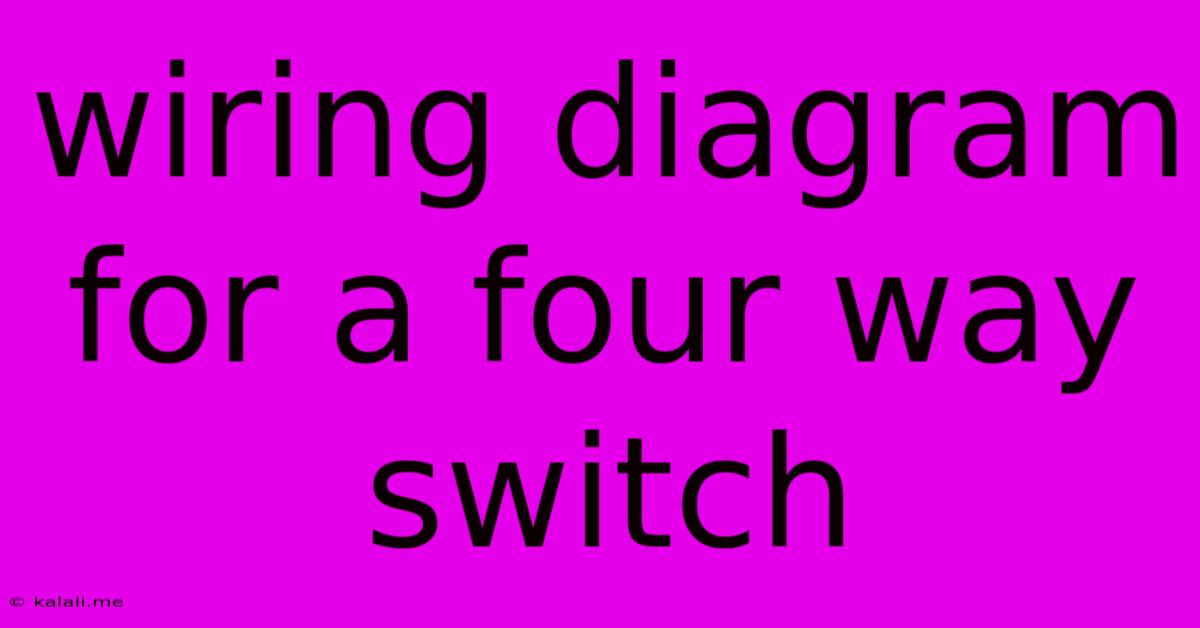Wiring Diagram For A Four Way Switch
Kalali
May 25, 2025 · 3 min read

Table of Contents
Understanding and Wiring a Four-Way Switch: A Comprehensive Guide
This article provides a detailed explanation of four-way switch wiring diagrams, guiding you through the process of understanding and installing this essential electrical component. A four-way switch allows you to control a light or other electrical device from three or more locations. This is more complex than a simple single-pole or three-way switch setup, but with clear instructions, it's a manageable project for experienced DIYers. Safety precautions are paramount; if unsure, always consult a qualified electrician.
What is a Four-Way Switch?
Unlike a standard single-pole switch which simply turns a circuit on or off, a four-way switch acts as an intermediary between two three-way switches. This arrangement allows for control of a light fixture from three or more locations. Three-way switches have three terminals, while a four-way switch typically has four. The four terminals allow the circuit to be switched on and off from the locations controlled by the three-way switches. Understanding this interaction is key to successful wiring.
Components Needed for a Four-Way Switch Circuit
Before diving into the wiring diagrams, let's outline the necessary components:
- Light Fixture: The device you want to control (e.g., a ceiling light, fan).
- Two Three-Way Switches: These switches allow you to control the light from two separate locations.
- One Four-Way Switch: This switch allows you to add a third (or more) control point.
- Electrical Wires: Sufficient length of appropriately sized electrical wire (refer to local building codes).
- Junction Boxes: To house the wiring connections safely and neatly.
- Electrical Tape: For securing wire connections.
Four-Way Switch Wiring Diagrams: A Step-by-Step Explanation
Several configurations are possible, depending on your specific setup. However, the core principles remain consistent. Here's a breakdown of a common configuration:
Diagram 1: Basic Four-Way Switch Configuration (Three Locations)
This diagram depicts a common scenario with three control locations:
- Location 1 & Location 3: Three-way switches.
- Location 2: Four-way switch.
The key is understanding the common travelers. These wires (usually black and red) carry the signal between the three-way switches, passing through the four-way switch without being directly switched. The power feeds into one of the three-way switches, then passes through the common travelers and finally reaches the light fixture.
(Include a simple, clear diagram here, showing the wiring from the power source to the three-way switch, then through the four-way switch to the other three-way switch, and finally to the light. Clearly label all wires: power (black), common (black), traveler (red & black), light (black).)
Diagram 2: Adding More Control Locations
Adding more locations involves using additional four-way switches between the three-way switches. Each additional control point requires another four-way switch, significantly increasing the complexity. It's crucial to maintain consistent wiring of the common travelers between switches.
(Include a simplified diagram here, showcasing the addition of another four-way switch and its connection to the existing circuit. Clearly label all wires.)
Troubleshooting Common Issues
- Light Doesn't Turn On: Check all connections for loose wires, shorts, and correct wiring according to the diagrams. Ensure the power is switched off before checking.
- Intermittent Functionality: Inspect the switch connections carefully for any potential breaks or loose wires.
- Switch Doesn't Respond: Verify the power supply is reaching the entire circuit.
Conclusion
Wiring a four-way switch system is a more advanced electrical project. Always prioritize safety, using appropriate safety equipment and following local building codes. While this guide provides a comprehensive overview, it's crucial to consult a qualified electrician if you lack the necessary experience. Remember that incorrect wiring can lead to electrical hazards. Proper planning and understanding of the circuit are essential for a successful installation.
Latest Posts
Latest Posts
-
How Long Can You Drive With A Spare Tire
May 25, 2025
-
How Long Does It Take For An Alignment
May 25, 2025
-
2014 Ford Mustang Check Chatging System
May 25, 2025
-
Why Does My Circuit Breaker Keep Tripping
May 25, 2025
-
Wear Your Heart On Your Sleeve Meaning
May 25, 2025
Related Post
Thank you for visiting our website which covers about Wiring Diagram For A Four Way Switch . We hope the information provided has been useful to you. Feel free to contact us if you have any questions or need further assistance. See you next time and don't miss to bookmark.